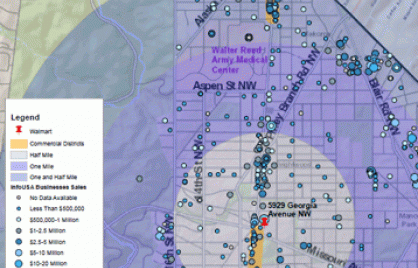
The DC Office of the Chief Technology Officer (OCTO) is playing a key role in the District’s preparations for the arrival of big-box giant Walmart.
As in many other localities, the prospect of Walmart’s arrival in the District has been controversial. Mayor Gray has demanded a series of concessions to make sure Walmart will provide jobs for District residents and not drive out local businesses, as critics fear.
“The arrival of Walmart will have significant impact on the District, and geospatial data will play an important role in evaluating that impact,” said District Chief Technology Officer Rob Mancini. “OCTO’s innovative GIS team will provide critical data on affected areas associated with this initiative. I am pleased that OCTO is making a valuable contribution to this major development in District history as part of Mayor Gray’s commitment to expand economic opportunity in DC.”
OCTO’s Geographic Information Systems (GIS) group has conducted a geospatial analysis of neighborhoods in the District where Walmart has proposed to locate. OCTO gathered current data on jobs and small business in these neighborhoods and mapped the data for easy visual representation. OCTO’s work will help the District assess Walmart’s impact and hold the giant retailer to its promises.
OCTO’s geospatial analysis covered the four future locations Walmart initially proposed--Missouri Avenue, NW at Georgia Avenue, NW; New Jersey Avenue, NW at H Street, NW; 58th Street, NE at East Capitol Street NE; and New York Avenue at Bladensburg Road, NE.
For each of these four sites, OCTO defined two potential impact areas, one within a half-mile radius, the other within a mile radius, with an additional 1.5-mile buffer for the Georgia Avenue site. For each impact area, OCTO mapped local businesses by type (e.g., grocery, convenience store, pharmacy) and then mapped data on two measures for each business: number of employees and annual sales volume.


